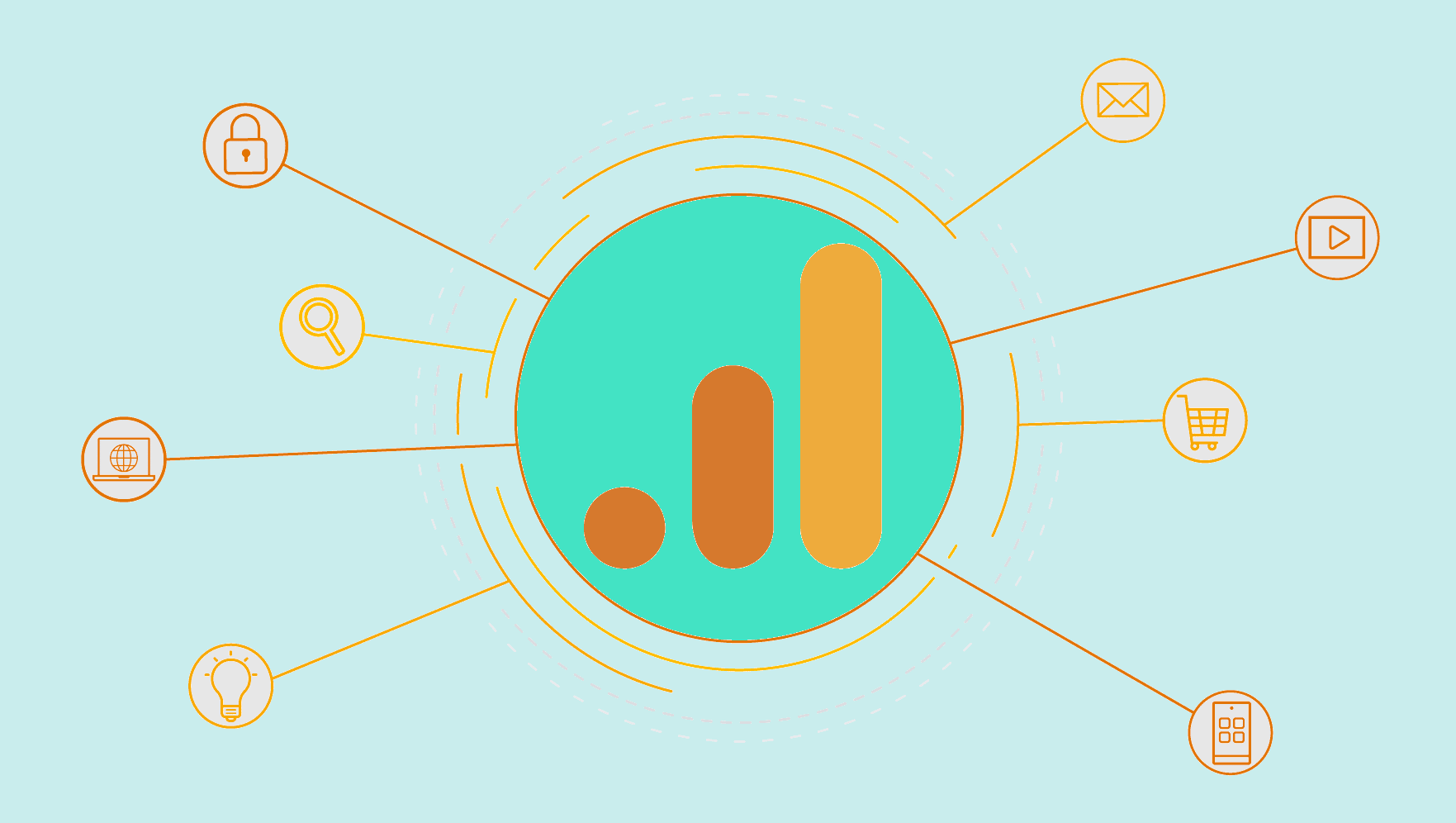Google Analytics 4 analyzes data from websites and applications to better understand how users use them. This new version also focuses on privacy, and uses artificial intelligence. Find out everything you need to know about GA4, and how to take a Google Analytics 4 training course to master this tool!
Whether for marketing, SEO or decision-making, websites and applications are goldmines of data. By analyzing them, it’s possible to better understand web users’ expectations and behavior.
However, in the past, tools such as Google Analytics were limited. They were mainly used to analyze traffic, but not the usage metrics needed to better understand the customer. Google realized that its existing analytical solutions did not offer a complete view of the cross-platform customer journey.
With Google Analytics 4, the new version of the tool, marketers can now analyze all important customer usage metrics. Analysis is no longer limited to traffic.
Formerly called “App + Web”, Google Analytics 4 was in beta until October 2020. According to Google, this major update aims to adapt to changes in internet usage and new web privacy laws such as the GDPR
The new tool tracks the entire customer journey across multiple platforms, and leverages AI and Machine Learning to provide detailed insights into how users interact with websites and apps.
What is Google Analytics 4?
Google Analytics 4, or GA4, is Google’s platform for analyzing website traffic data. This tool can be used for both websites and applications to analyze data in a centralized manner.
It allows you to measure customer segmentation, conversion rates, analyze expenses, user events, and device categories, among other metrics.
The main innovation in GA4 is the incorporation of Machine Learning and Artificial Intelligence. These technologies provide more insights into customer behavior, enabling better strategic decisions and improving conversion rates or enhancing marketing content.
Another key feature is that GA4 operates on an “event-driven” model. This means it perceives customer behavior as a series of events and provides analysis based on these events.
The goal of this platform is to provide more data throughout the customer’s journey. More data is available after a customer has been acquired, including insights into their engagement level, monetization, and retention.
Comment fonctionne Google Analytics 4 ?
To meet the needs of businesses, Google Analytics 4 adopts a Machine Learning-based approach. This allows for cross-platform insights while preserving user privacy.
Through data analysis, users can understand their customers and track them across different devices. This tool enables continued data analysis for websites, despite restrictions on the use of cookies and identifiers.
Some AI features have been available since 2016, but several significant new features are worth highlighting. Automatic alerts are generated for data trends, such as increased demand for a specific product.
The platform is also capable of predicting customer actions by calculating the probability of churn. It offers predictive metrics, such as revenue estimation for audience groups.
Google Analytics vs Universal Analytics: what's the difference?
Universal Analytics is the standard version of Google Analytics. It has several major differences from GA4.
Deep integration with Google Ads
First and foremost, Google Analytics 4 provides deep integration with Google Ads. It allows for measuring conversions both on the website and the app for Google Ads, YouTube Ads, third-party channels like Facebook, and organic channels like web search or email.
This integration between web and app data simplifies measuring the overall impact of marketing investments, regardless of the acquisition channel.
Customer-centric measures
Secondly, this update takes a customer-centric approach. It allows tracking the customer journey, even if it’s a fragmented experience involving multiple devices and platforms.
The GA4 tool uses multiple identity spaces, including user IDs provided by the marketer and unique Google signals from users who have opted for ad personalization.
This enables an overview of how customers interact with your business. The goal here is to understand precisely where customers come from and what their interactions are throughout the journey.
Un reporting plus complet
Another new feature concerns reporting. To simplify tracking the customer, Google has added a new “Lifecycle” section that includes reports on acquisition, engagement, monetization, and retention.
In the past, only the acquisition report was available on Google Analytics. These new options provide more visibility into the subsequent stages of the customer lifecycle.
A new reporting feature has also been added to the “Analysis” section. It offers several templates for analyzing conversion funnels, user journeys, and cohort analysis.
Enhanced privacy protection
Finally, Google Analytics 4 is designed to adapt to the new requirements for privacy protection. This new version offers granular controls for data collection, retention, and analysis of user data.
The new data collection approach does not use cookies or identifiers. It relies on data modeling to fill gaps in the customer journey when data is incomplete or inaccessible.
In June 2022, Google announced that Universal Analytics would stop processing new data from July 1, 2023. Subsequently, all data processing will end on October 1, 2023. Therefore, Google Analytics 4 will be the only available tool for measuring website activity.

Google Analytics 4 features
In addition to enhancing Universal Analytics features, Google Analytics 4 also introduces new functionalities. Here’s an overview of the innovations in this version.
The Advertising Workspace is a dashboard that provides a snapshot of advertising on the website or app. It also allows you to view resources like model comparison and conversion paths in the “Attribution” tab.
Model comparison enables you to add filters based on five conditions, such as the gender and age distribution of visitors. After adding the conditions, you can customize the reports to define the preferred view between visitor interaction time and conversion time.
The conversion paths feature helps you understand the customer journey that led to conversion. It presents the total revenue generated from website or app purchases and indicates the number of days and interactions with ads before conversion.
The cohort exploration feature allows you to group website users into cohorts by selecting users that meet specific criteria. You can then monitor their behavioral changes over time.
Finally, the predictive metrics feature allows you to predict potential buyers, customer attrition probability, or revenue opportunities. Simply create an audience and add comparison metrics, similar to the conditions for model comparison. The audience can be analyzed by platform, device category, or app version.
Google Analytics 4: what impact does it have on data?
Migrating to Google Analytics 4 can have a significant impact on your data. Firstly, Machine Learning enables you to receive insights into the likely behavior of customers.
These insights can be leveraged to enhance the customer experience across various device categories on your platforms. Additionally, data analysts can receive alerts about significant trends and make better decisions regarding product offerings or website content.
Predictive metrics and customer behavior analysis also allow for predicting probable revenues for the organization over a specific period. This enables advertising teams to focus their ads more effectively on the cohort of customers most likely to generate these revenues.
Managers can decide how to attract this cohort, while sales and marketing teams can concentrate on conversion. Overall, GA4 can enhance the productivity of the entire organization.

How do I migrate to Google Analytics 4?
If you’re setting up a new property, Google Analytics 4 will be the default option. However, if you’re still using the old version, you’ll need to transition by configuring both implementations simultaneously.
It’s recommended to create a new GA4 property as soon as possible because you can’t import data from the old version. It’s better to start collecting data and getting familiar with the tool before completely replacing the old version. This is the method Google recommends for transitioning.
Even though you can’t import all the old data from Universal Analytics to Google Analytics 4, both accounts will be linked. So, you can use the GA4 setup assistant to migrate configurations from the Universal Analytics property to the new one.
Also, note that Google Analytics 4 properties no longer use the “Views” reporting structure but instead use “Data Streams.” During setup, you’ll need to connect a Data Stream and configure it for your website or app.
The “Enhanced Measurement” option is an intuitive tracking system that can be enabled with a simple toggle switch for a web Data Stream. For app Data Streams, you’ll be guided through the configuration and will need to install the Firebase SDK.
How do I configure Google Analytics 4?
If you don’t have a Google Analytics account yet, the first step is to create one on the official website. Then, go to the “Admin” section of your Google Analytics account and click on “Create an account.”
You can analyze data from one or multiple properties, such as websites, mobile apps, or point-of-sale devices. After choosing a name, click “Next” to add a property to the account.
If you already have a Google Analytics account, simply log in. Go to the “Admin” section and select the appropriate client account. Then, go to the “Property” section and click “Create property.”
Enter a name, timezone, and currency. You’ll need to specify an industry category and business size, then accept Google’s terms of service.
After creating the property, you’ll need to add data streams for Web, iOS, or Android. Go to Admin > Data streams > Property, choose the stream type, and follow the setup instructions. Click the create stream button and repeat this process for each stream you want to add.
The final step is to add tags to your website. Go to the Google Analytics 4 property you created and click on the Web data stream.
For popular CMS platforms like Wix, WordPress, or WooCommerce, you’ll need to find the “G”-ID code to place in the Google Analytics field in the backend. Go to Admin > Property > Data streams > Web and look for the “Measurement ID” code. Copy it and follow the instructions for your specific CMS platform.
How to take a Google Analytics 4 training course
Google Analytics 4 is a very useful tool for businesses to analyze data from websites and applications. It also provides access to Machine Learning and Data Science features that were previously only available in Google Analytics 360.

However, Google Analytics 4 is just one of the many existing data analytics solutions. To learn how to use the best data analysis tools and techniques, you can choose DataScientest.
Our Data Analyst training program allows you to become an expert in Python, Data Visualization, Big Data, Machine Learning, and Business Intelligence. At the end of the course, you will have all the skills required to work as a data analyst.
This program allows you to obtain a certificate from Mines ParisTech PSL Executive Education, validate Block 3 of the RNCP 36129 certification “Artificial Intelligence Project Manager” recognized by the French government, and prepare for the Microsoft PL-900 certification to become a Microsoft Certified Power Platform Fundamentals.
All our training programs focus on practical learning with a continuous project and adopt a Blended Learning approach that combines learning on a coached platform and Masterclasses.
Our programs are fully teached online via the internet and are eligible for funding options. Discover DataScientest now!
Now you know all about Google Analytics 4 training. For more information on the subject, take a look at our complete dossier on the Data Analyst profession and our dossier on data analysis.










